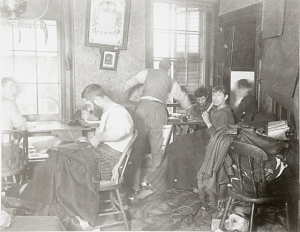Sweatshops of the Past and Present

You would be surprised how many similarities the sweatshops of the past have to the ones of today. In the past, during the late 1800s, many families, especially immigrants lived in small tenements. The majority eventually began their own garment business within their own homes with manual machines.

In fact, immigrants created more than 60% of the clothes for women in America during this time. The fabric dust commonly caused lung issues. This is still true today, but unlike in the past, the majority of the workers are women. If clothing appears to have been done by hand, like embroidery, “there’s a good chance the garment was quite literally homemade, at least in part—and most likely by a woman who was paid a pittance for it.” 1 By the early 1900s, garment making had shifted. Many people began working in factories, but they were still mostly immigrants. Today immigrants are still exploited to work in sweatshops, but especially in developing countries, the workers may be citizens or migrants. Both had extreme work hours, disease, and poor working conditions. Child labor is a huge problem especially

today. Children in the past worked, but in the case of sweatshops producing garments, many children did small tasks like transporting smaller items. Today “in developing countries, an estimated 168 million children ages 5 to 14 are forced to work.” 2 Immigration is heavily connected to sweatshop labor. Coming to a new country, especially one where the language is different, is extremely difficult. The work you can do without knowing English or having connections is limited to labor-intensive work. This includes sewing in sweatshops. One woman was “lured to the United States by a human trafficker promising a good job as a nanny. She was exploited, undocumented, and unable to speak either English or Spanish.” 3 Immigrants are easily taken advantage of because of their lack of support and the temptation of a new and better life. Many of those who are first-generation immigrants take these jobs to get a footing in a new place and plan to have their children learn English and get better jobs in the future. Despite the poor conditions and pay, sweatshops have a silver lining. In history, immigrants could eventually rise the ranks of wealth to live a mostly comfortable wife. For example, one family living in a tenement in New York City was eventually able to gain enough money to start their own garment factory and move to a new building. Even if one is unable to do this, they have a job at the very least. Today ideas for anti-sweatshop laws would prevent America from importing goods made in sweatshops. Unfortunately “anti-sweatshop laws would make third-world workers worse off by lowering the demand for their labor.” 4 Despite the sweatshops not being good work, at the current moment, without them, many people would be living even worse than they are.
Work Cited and Footnotes
1 Bain, Marc. “A Huge Underclass of Ghost Workers Are Making Your Shirts in Their Homes.” Quartz. Quartz, January 20, 2016. https://qz.com/494818/in-much-of-the-world-the-sweatshop-isnt-a-factory-its-someones-kitchen-floor/.
2 “11 Facts About Sweatshops.” DoSomething.org. Accessed February
3 Davis, Charles. “The Dark Side of Your Clothes Being ‘Made in America’ No One Talks About.” ATTN. ATTN: July 26, 2017. https://archive.attn.com/stories/18483/made-america-how-sweatshops-exploit-immigrants-make-your-clothes.
4 Powell, Benjamin, Craig J. Richardson, Jon Murphy, John Schuler, Jeffrey Rogers Hummel, Charles L. Hooper, and David R. Henderson. “In Defense of ‘Sweatshops.’” Econlib, June 3, 2019. https://www.econlib.org/library/Columns/y2008/Powellsweatshops.html.